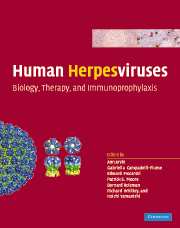Book contents
- Frontmatter
- Contents
- List of contributors
- Preface
- Part I Introduction: definition and classification of the human herpesviruses
- Part II Basic virology and viral gene effects on host cell functions: alphaherpesviruses
- Part II Basic virology and viral gene effects on host cell functions: betaherpesviruses
- Part II Basic virology and viral gene effects on host cell functions: gammaherpesviruses
- Part III Pathogenesis, clinical disease, host response, and epidemiology: HSV-1 and HSV-2
- Part III Pathogenesis, clinical disease, host response, and epidemiology: VZU
- Part III Pathogenesis, clinical disease, host response, and epidemiology: HCMV
- Part III Pathogenesis, clinical disease, host response, and epidemiology: HHV- 6A, 6B, and 7
- Part III Pathogenesis, clinical disease, host response, and epidemiology: gammaherpesviruses
- Part IV Non-human primate herpesviruses
- Part V Subversion of adaptive immunity
- Part VI Antiviral therapy
- 64 Antiviral therapy of HSV-1 and -2
- 65 Antiviral therapy of varicella-zoster virus infections
- 66 Antiviral therapy for human cytomegalovirus
- 67 New approaches to antiviral drug discovery (genomics/proteomics)
- 68 Candidate anti-herpesviral drugs; mechanisms of action and resistance
- Part VII Vaccines and immunothgerapy
- Part VIII Herpes as therapeutic agents
- Index
- Plate section
- References
64 - Antiviral therapy of HSV-1 and -2
from Part VI - Antiviral therapy
Published online by Cambridge University Press: 24 December 2009
- Frontmatter
- Contents
- List of contributors
- Preface
- Part I Introduction: definition and classification of the human herpesviruses
- Part II Basic virology and viral gene effects on host cell functions: alphaherpesviruses
- Part II Basic virology and viral gene effects on host cell functions: betaherpesviruses
- Part II Basic virology and viral gene effects on host cell functions: gammaherpesviruses
- Part III Pathogenesis, clinical disease, host response, and epidemiology: HSV-1 and HSV-2
- Part III Pathogenesis, clinical disease, host response, and epidemiology: VZU
- Part III Pathogenesis, clinical disease, host response, and epidemiology: HCMV
- Part III Pathogenesis, clinical disease, host response, and epidemiology: HHV- 6A, 6B, and 7
- Part III Pathogenesis, clinical disease, host response, and epidemiology: gammaherpesviruses
- Part IV Non-human primate herpesviruses
- Part V Subversion of adaptive immunity
- Part VI Antiviral therapy
- 64 Antiviral therapy of HSV-1 and -2
- 65 Antiviral therapy of varicella-zoster virus infections
- 66 Antiviral therapy for human cytomegalovirus
- 67 New approaches to antiviral drug discovery (genomics/proteomics)
- 68 Candidate anti-herpesviral drugs; mechanisms of action and resistance
- Part VII Vaccines and immunothgerapy
- Part VIII Herpes as therapeutic agents
- Index
- Plate section
- References
Summary
Introduction
The discovery of effective antiviral agents has been facilitated by advances in the fields of molecular biology and virology. In the pre-antiviral era, the widely held belief was that any therapeutically meaningful interference with viral replication would destroy the host cell upon which viral replication was dependent. A growing understanding of host cell–virus interactions and viral replication, however, has led to the development of safe and effective antivirals. These agents act by impeding entry of viruses into host cells; interfering with viral assembly, release, or de-aggregation; inhibiting transcription or replication of the viral genome; or interrupting viral protein synthesis.
Antiviral agents can be used to treat disease (a therapeutic strategy), to prevent infection (a prophylactic strategy), or to prevent disease (a preemptive strategy). Prophylaxis refers to the administration of an agent to patients at risk of contracting infection (e.g., acyclovir given to HSV-seropositive renal transplant recipients). Pre-emptive treatment refers to the administration of a drug after there is evidence of infection, but before there is evidence of disease (e.g., ganciclovir given to bone marrow transplant recipients with positive CMV culture, but no symptoms of infection).
The effectiveness of antiviral therapy sometimes is limited by the development of antiviral resistance. Antiviral drug resistance has increased in parallel with the expanded use of, and indications for, antiviral therapy. Resistance most commonly occurs in patients with chronic and/or progressive infections who have been exposed to prolonged or repeated courses of therapy.
- Type
- Chapter
- Information
- Human HerpesvirusesBiology, Therapy, and Immunoprophylaxis, pp. 1153 - 1174Publisher: Cambridge University PressPrint publication year: 2007
References
- 29
- Cited by

